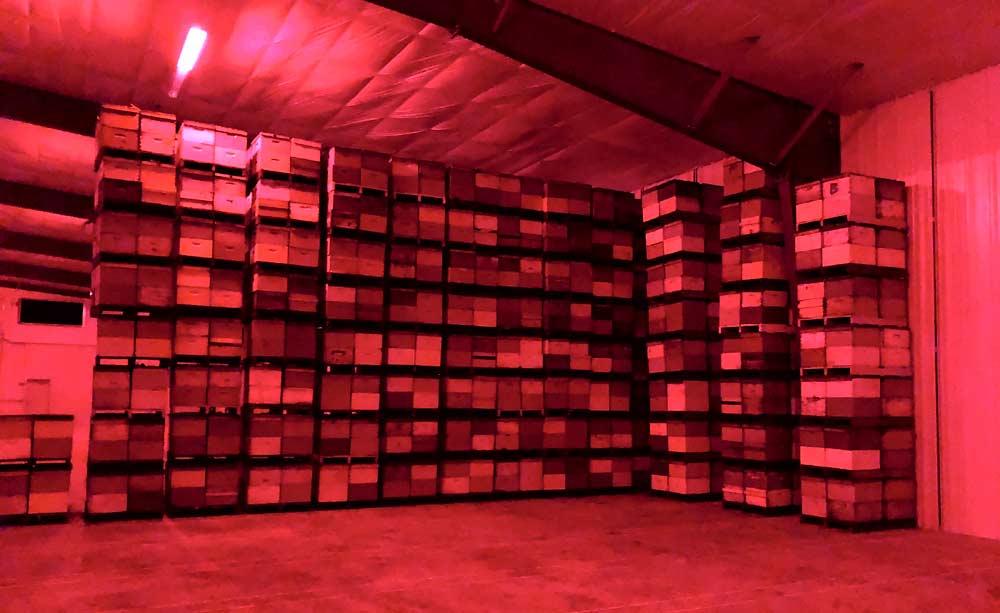
Could storing honeybee hives in CA warehouses help bees fight off the threat from Varroa mites? Initial experiments from a Washington beekeeper and Washington State University researchers show that cold storage and increased carbon dioxide levels benefit bees. (Courtesy Brandon Hopkins)
Years ago, Canadian researchers studying overwintering honeybee hives found that in cold conditions, carbon dioxide naturally rises in the hives as the bees cluster tightly together, to no apparent ill-effect.
That gave longtime Yakima Valley beekeeper Eric Olsen an idea.
“I had a catastrophic loss a few years in a row that almost bankrupted me, so I couldn’t keep taking bees to California and putting them in a holding yard,” recalled Olsen, now retired from the bee business. “I had a friend in Idaho who had been wintering his bees inside for some time, using potato cellars, and of course, we don’t have potato cellars but we have lots of CA rooms.”
So he moved hives to a friend’s old apple warehouse and closed the door — putting the bees in a dark, cool environment that basically puts the whole colony to bed. Closing the door in the sealed storeroom meant the bees’ breathing would elevate carbon dioxide levels, so Olsen installed monitors to track the CO2.
He wanted to keep it below 5 percent, which was what the bees withstood with no problems in the Canadian research, so every day he kept the doors closed and every night, when levels got high, they opened the doors and turned on fans to clear the air. Come dawn, the doors were closed again, so the bees got to rest in perpetual darkness and Olsen didn’t have to worry about them suffocating.
“The results were just phenomenal,” he said. “I had three years in a row where my loss was in the single digits.”
The benefits came in part from keeping the bees safe and rested, but the experiment also made it much, much easier to control Varroa mites, the scourge of commercial beekeeping.
That’s because during storage, the queen stopped laying eggs. In California holding yards where hives typically overwinter, bee activity slows down but queens keep up some laying.
Varroa mites parasitize larvae, so they need the bees to reproduce so they can reproduce. More importantly, all the mites inside the larvae are protected from miticides, said Brandon Hopkins, an entomologist at Washington State University who has been working with Olsen on storage experiments.
If you force the hive to take a break from brooding, it forces all the mites out on their own, making them much more susceptible to pesticides.
“When they came out of CA storage, we hit them with a product called HopGuard. It’s a wonderful product in that it’s very gentle on the bees, but not usually virulent enough to bail you out of a bad mite problem,” Olsen said. But after a winter without bee larvae, the remaining mites were “on their last legs” and the HopGuard took them all out as the bees started their spring work in California almond orchards.
Additional experiments with Olsen show the bees that overwinter in the CA storage emerge healthier, with more fat and protein reserves.
Even more exciting, lab experiments with a few hives in small chambers have led Hopkins to believe that the elevated CO2 also directly kills the mites at levels the bees can easily survive. Small-scale studies out of Canada have found similar results.
To test and fine-tune this theory into commercial mite control strategies, Hopkins is seeking a grant from the Washington Tree Fruit Research Commission to build larger climate control chambers for further, more controlled experiments.
Then he plans to apply for more grants from other sources to fund this developing research program at WSU-Pullman.
“We need to scale this from tiny lab studies to medium scale so that beekeepers will feel confident putting their hives in CA and investing in this,” Hopkins said in his pitch to the commission in January.
Some beekeepers, like Olsen, are already running their own experiments in potato sheds equipped with swamp coolers, but controlled atmosphere facilities will allow researchers to really understand what levels of CO2 and humidity work best and for how long.
Humidity is key, because Hopkins thinks CO2 kills mites through dehydration. Elevated CO2 causes insects to leave their breathing tubes open, and they lose water through those tubes, he said. Similar techniques are sometimes used to kill grain pests.
“The mites are far more subject to drying out (than bees) because they are smaller and have much more surface area,” he said. Plus, the large bees have access to honey, which many help them replenish lost moisture.
If they can prove that a few weeks at say, 8 percent C02, will kill mites but not bees, that could become a management strategy for commercial beekeepers during the winter or during a break in the summer season to reduce mite pressure.
“That use of refrigerated rooms to cause a break in brooding could be the biggest thing in beekeeping since Varroa mites,” Hopkins said.
In the long run, he thinks storage rooms built for fruit could be repurposed for bee storage, providing increased stability to the commercial honeybee industry and everyone else who depend on its pollinators. •
—by Kate Prengaman






Leave A Comment